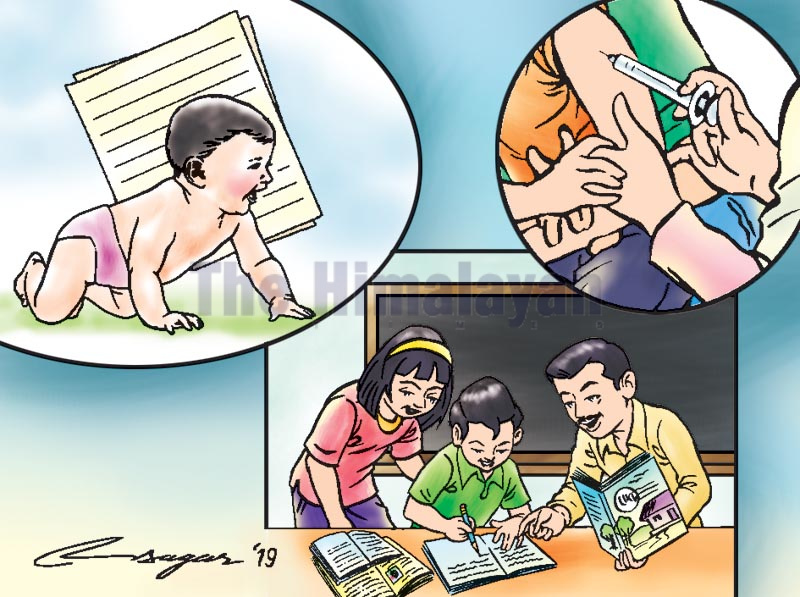Child rights march: Partnership for progress
Actors responsible for ensuring the rights of children must be determined to implement meaningful child-centred policies, further good governance, enhance investments and allocate the necessary resources for the advancement of children’s rights
Three decades ago, the world was in the midst of great change. With the fall of the Berlin Wall, decline of apartheid and the birth of the World Wide Web, governments around the world were in confusion about the direction to take. Against this backdrop of change, leaders of the world came together to ensure the world’s children their right to a future.
The Convention on the Rights of the Child (CRC), held in 1990, was an important milestone in ensuring their right to protection, survival, development and participation.
Nepal ratified the CRC in 1990, which was followed by the enactment of the Children’s Act in 1992. Subsequently, a 10-year plan of action for child development was developed, the first of its kind in Nepal. The Act also provisioned for the formation of a separate statutory committee to work for the rights of children.
As such, the commitments made at the international level obligated the country to implement the principles and provisions of these instruments as well as enforce, amend and reform legislation and policy context concerning child rights and protection.
In the past 30 years, Nepal has made tremendous progress in improving the situation of children and realisation of their rights. Nepal has ratified most of the international and regional human rights apparatuses concerning children.
With the promulgation of the Constitution of Nepal 2015, the country has been politically delineated into 753 local level governments in 77 districts under seven provinces. The local governments have made significant progress in adopting the pillars of CRC. The country is motivating all related actors to invest for realising the concept of leaving no one behind. In the last 30 years, Nepal has made substantial progress in ensuring equal access to education, with gender parity in primary and secondary level school enrolment. The vision of “Prosperous Nepal, Happy Nepali” targets ensuring child rights and child-friendly governance. A vital registration like birth registration was recognised as a legal right only after the 1992 Children’s Act was put in place. Today birth registration has reached 56 per cent.
Against this background, the recently enforced Children’s Act, 2018 has added a milestone in ensuring the rights of children in federalism. The Act, in line with the principles and provisions of the CRC, establishes the right of children to dignity, name, citizenship and identity, non-discrimination, maintaining contact with parents and families, protection from all sorts of harm, participation, expression of opinions, obtaining information and right to association, right to privacy and confidentiality, special rights of children with disabilities, right to nutrition and health, sports, leisure and cultural rights, and right to education.
Similarly, various sectoral policies have been implemented, including the National Strategy to end Child Marriage, 2015 (with the goal to end it by 2030) and National Master Plan on Elimination of Child Labour, 2018 (by 2025). These are under implementation and targets to eliminate all sorts of violence against children through a rights-based approach. But there are still some challenges in realising the CRC.
Some 35.8% of children under 5 years suffer from stunting, about 1.6 million children are engaged in child labour, 44% of children still have not obtained their birth certificate, and Nepal still has one of the highest child marriage cases in the world. Children with disabilities, those coming from a minority background or living in disadvantaged and vulnerable situations require even more attention. These and other development agenda demand multi-stakeholders’ support, led by the government, with the development partners, communities, children themselves, local and international NGOs and faith leaders chipping in.
Changing context, changing ways of bringing up children, changing climate, urbanisation, globalisation, pollution, conflicts, modern gadgets, migration, remittance - these changes that children face today in 2019 were unimaginable to the children of the 1980s. Children’s increasing access to information about the world is also threatening their safety. The trends and nature of violence against children are also changing. In this changed context, childhood is changing, and to bring solutions to such problems, the government and organisations investing in children must also change their interventions. The engagement of children and bringing children’s voices in decision-making are an immediate need to live up to the commitments under the SDGs in Nepal.
In the real world, children are a majority in statistics but minority in social status. Society and NGOs have a role in implementing the rights of children. The promulgation of the constitution and children-specific policies to ensure a legal framework alone will not be sufficient in the changed context today.
Actors responsible for ensuring the rights of children must be determined to implement meaningful child-centred policies, further good governance, enhance investments and allocate the necessary resources for the advancement of children’s rights. For this purpose, multi-stakeholder partnerships, including with the civil society, must be built.






